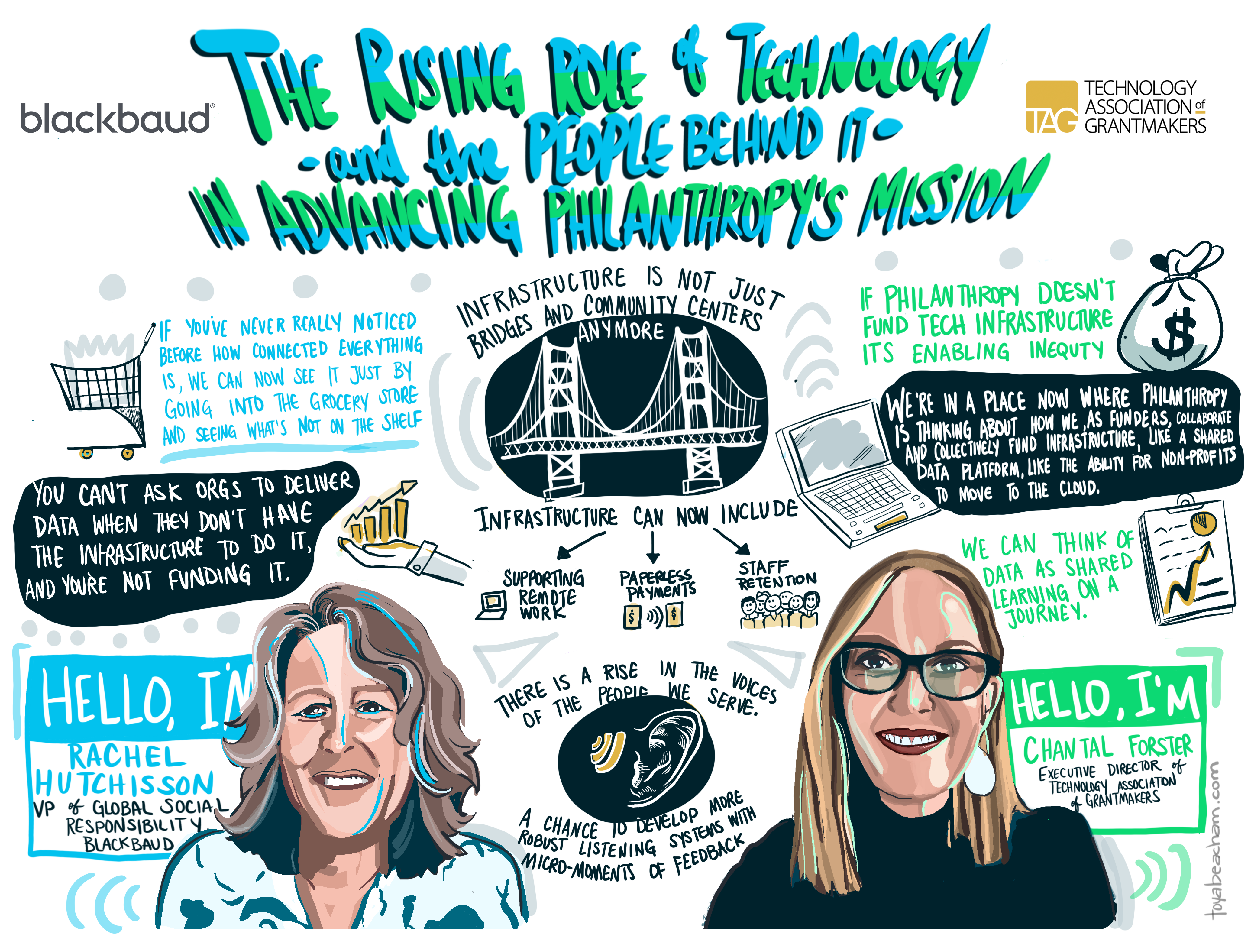How Grantmakers Can Support Nonprofit Infrastructure Needs: A Conversation with Chantal Forster

For decades, “infrastructure” referred to the physical and tangible needs of a business or a community. The buildings we work in. The roads we drive on. The wires that carry electricity to our offices. These days, infrastructure means more than just steel, asphalt, and copper. It means servers, software, and policies that enable organizations to scale.
In a recent webinar, Blackbaud’s VP of Global Social Responsibility Rachel Hutchisson talked with Chantal Forster, the executive director of the Technology Association of Grantmakers (TAG), about how the role of technology in today’s charitable organizations no longer hides behind a door marked “IT.” It runs throughout the organization, and grantmakers must account for it in their funding opportunities.
Grantmakers need to recognize the importance of funding both the projects and the technology required to support, measure, and grow those projects.
What Infrastructure Looks Like to Today’s Nonprofit
As Rachel mentioned during the webinar, the world has become both global and hyperlocal at the same time. “If you have never really noticed before how connected everything is, we can now see it just by walking into the grocery store and seeing what’s not on the shelf,” she said. Though it means something different than it did 30 years ago, infrastructure is still a key part of any organization and its connection to the world around it. These are the types of infrastructure projects today’s nonprofits are focused on:
- Cloud-based solutions: Nonprofit leaders and staff must have the ability to access information anywhere, anytime, and have access to the servers to support it.
- Software to help measure impact: In order to provide the reporting and trends data to stakeholders, today’s nonprofit needs more than just Excel to manage data and identify insights.
- Improved data security: Nonprofit organizations manage sensitive data, from payment information to individual constituent contact information, that they need to protect so they can maintain the trust of their communities.
- Improved employee wellness through hybrid and remote options: Organizations need to be able to support a variety of scenarios—from in-office to remote and everything in between—to weather the full range of potential disruptions and attract the best talent.
According to Chantal, “We’re in a place now where philanthropy is thinking about how do we, as funders, collaborate and collectively fund infrastructure, like a shared data platform, like the ability for nonprofits to move to the cloud.”

Recognizing the Rise in the Voices the Organization Serves
Being closer to the community, individual nonprofits can see the issues affecting their clients. Sometimes that requires a pivot, despite the funding parameters. Technology has provided greater options for feedback and communication between grantees and funders, if the infrastructure is there.
As she shared during the webinar, Chantal is seeing a desire to shift to a customer-experience mindset, where funders rely less on surveys and more on passive ways of understanding. “This is a chance to develop more robust listening systems with micro-moments of feedback,” she said, such as identifying friction in the application process.
Another issue grantees continue to discuss is the prevalence of long and cumbersome application processes. In a follow-up conversation, Chantal mentioned the movement to “fix the form” and for grantmakers to take a hard look at their application processes. It’s almost been one year since the launch of the movement and Chantal admits to some soul-searching as to what progress, if any, the industry has made since TAG released the findings that nearly 40% of our grant applications are duplicative.
In the application process and throughout the grantee relationship, grantmakers should be sure to only ask for data that they need. And if they need the data, the grant should include funds to help the organization gather and analyze it. “You can’t ask organizations to deliver data when they don’t have the infrastructure to do it and you’re not funding it,” Rachel said.
After two years of disruption, many organizations are working to include principles of trust-based philanthropy, giving grantees more flexibility to meet the needs they see. While this values-based approach is often a process for traditional foundations, Chantal recommends any organization implementing it should also set up listening structures to make sure the approach is helping (and not hindering) the grantees.
How Infrastructure Enables More Equitable Grantmaking
The infrastructure Rachel and Chantal discussed is not optional for today’s nonprofit. During times of change, the burden falls on traditionally underfunded and small community-oriented nonprofits to switch their focus to infrastructure at the expense of their clients or create workarounds. Funding the programs but not the technological infrastructure that supports them forces grantees to choose between existing and scaling.
In addition to funding infrastructure projects, grantmakers can provide access to their own policies and best practices to help smaller organizations build a strong technological infrastructure. They can also organize a peer network for support. As a funder, they can also do larger-scale societal field-level outcomes and data analysis in the impact area, instead of asking their grantees to take time away from their mission to compile that information.
Using Infrastructure to Drive Change
The technology, while foundational, is just the start. Funding infrastructure, whether it’s data or technological infrastructure, is not just about the tool. In the end, funders need to work with their grantee partners on the strategy for implementing that tool, including how data flows between the elements of your tech stack, and how the individual tools are integrated.
Hear the full conversation with Chantal and Rachel with the recorded webinar, “The Rising Role of Technology—and the People Behind It—in Advancing Philanthropy’s Mission.”


